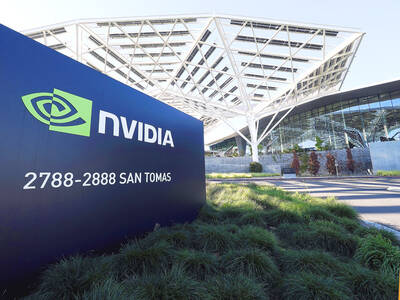Intel Corp is trying to sell its new laptop chips in an old way — by emphasizing their speed.
The world’s biggest chipmaker is touting the clock speed of its new H line of processors, citing their ability to process data at more than 5 gigahertz (GHz), or 5 billion cycles per second.
“Frequency is the thing we’ve optimized for... These are the first mobile processors to break 5GHz,” Intel general manager Fredrik Hamberger said.
Laptops based on these new 10th-generation Core design chips are to start appearing this month.
The top-of-the-range part can count as fast as 5.3GHz when operating in “Turbo Boost” mode, Intel said.
That targets video gamers and professional content creators, who often influence what is considered the best PC hardware.
The new products are being rolled out as Intel faces rising threats to its industry leadership. Smaller rival Advanced Micro Devices Inc (AMD) started fielding more competitive chips about two years ago.
Intel pioneered the sale of processors based on clock speed.
In 2001, then-Intel president Paul Otellini promised that Intel’s Pentium design would scale all the way to 20GHz.
However, the firm’s engineers underestimated how much power was needed, and how much heat would be generated by such chips.
As the new century progressed, laptops became more popular, and those slim designs could not handle power-hungry, hot processors as well as desktop machines. So Intel and the industry started making multicore semiconductors that combined several processors into one.
Performance is now measured by the ability to run different workloads at the same time, rather than pure speed.
AMD sells new processors that have more cores than Intel chips, garnering praise from gamers and PC reviewers. That has helped the smaller company take market share from Intel.
Intel has also struggled to maintain its lead in manufacturing technology.
AMD outsources manufacturing to specialists such as Taiwan Semiconductor Manufacturing Co (TSMC, 台積電), which has production technology that is well ahead of Intel’s.
The new H range of Intel chips are made with 14-nanometer production technology.
The company originally planned to upgrade to 10-nanometer in 2017, but that is only beginning to happen in mass volume this year.
AMD’s latest processors use TSMC’s 7-nanometer capabilities.
Intel has said that most video games do not take advantage of multicore chips and are best served by higher clock speeds.
About 60 percent of the new models in the H range would be capable of hitting 5GHz or higher, it said.
That speed is only achieved in short bursts on a limited number of cores, or just a single core in a “turbo” mode that shuts down other cores.
The base rate, the normal operating speed of the chips, is between 2GHz and 3GHz, where most of the industry’s products have been for more than a decade.

CHIP RACE: Three years of overbroad export controls drove foreign competitors to pursue their own AI chips, and ‘cost US taxpayers billions of dollars,’ Nvidia said China has figured out the US strategy for allowing it to buy Nvidia Corp’s H200s and is rejecting the artificial intelligence (AI) chip in favor of domestically developed semiconductors, White House AI adviser David Sacks said, citing news reports. US President Donald Trump on Monday said that he would allow shipments of Nvidia’s H200 chips to China, part of an administration effort backed by Sacks to challenge Chinese tech champions such as Huawei Technologies Co (華為) by bringing US competition to their home market. On Friday, Sacks signaled that he was uncertain about whether that approach would work. “They’re rejecting our chips,” Sacks

NATIONAL SECURITY: Intel’s testing of ACM tools despite US government control ‘highlights egregious gaps in US technology protection policies,’ a former official said Chipmaker Intel Corp has tested chipmaking tools this year from a toolmaker with deep roots in China and two overseas units that were targeted by US sanctions, according to two sources with direct knowledge of the matter. Intel, which fended off calls for its CEO’s resignation from US President Donald Trump in August over his alleged ties to China, got the tools from ACM Research Inc, a Fremont, California-based producer of chipmaking equipment. Two of ACM’s units, based in Shanghai and South Korea, were among a number of firms barred last year from receiving US technology over claims they have

BARRIERS: Gudeng’s chairman said it was unlikely that the US could replicate Taiwan’s science parks in Arizona, given its strict immigration policies and cultural differences Gudeng Precision Industrial Co (家登), which supplies wafer pods to the world’s major semiconductor firms, yesterday said it is in no rush to set up production in the US due to high costs. The company supplies its customers through a warehouse in Arizona jointly operated by TSS Holdings Ltd (德鑫控股), a joint holding of Gudeng and 17 Taiwanese firms in the semiconductor supply chain, including specialty plastic compounds producer Nytex Composites Co (耐特) and automated material handling system supplier Symtek Automation Asia Co (迅得). While the company has long been exploring the feasibility of setting up production in the US to address

OPTION: Uber said it could provide higher pay for batch trips, if incentives for batching is not removed entirely, as the latter would force it to pass on the costs to consumers Uber Technologies Inc yesterday warned that proposed restrictions on batching orders and minimum wages could prompt a NT$20 delivery fee increase in Taiwan, as lower efficiency would drive up costs. Uber CEO Dara Khosrowshahi made the remarks yesterday during his visit to Taiwan. He is on a multileg trip to the region, which includes stops in South Korea and Japan. His visit coincided the release last month of the Ministry of Labor’s draft bill on the delivery sector, which aims to safeguard delivery workers’ rights and improve their welfare. The ministry set the minimum pay for local food delivery drivers at